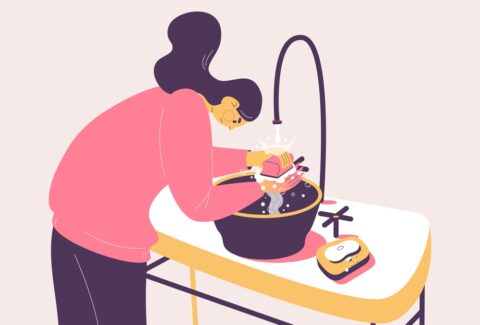Belief and CBT
Why are beliefs so crucial in CBT? What’s the big deal? What’s all the fuss about?
To answer these questions, let’s see what several experts in their respective fields and the best of the best have to say about belief.
1. Oscar Wilde said, “A thing is not necessarily true because a man dies for it.”
2. Mahatma Gandhi: “To believe in something, and not to live it, is dishonest.”
3. Don Miguel Ruiz: “We only see what we want to see; we only hear what we want to hear. Our belief system is just like a mirror that only shows us what we believe.”
4. Muhammad Ali: It’s the repetition of affirmations that leads to belief. And once that belief becomes a deep conviction, things begin to happen.”
5. William James: “Believe that life is worth living and your belief will help create the fact.”
Now, let us look at the definition of belief. In general, belief is defined as: “The acceptance that something exists or is true, especially one without proof.” In cognitive parlance, that which has been accepted to exist or to be true even without proof starts as a thought, an idea, or a concept; it starts as an opinion, an impression, or an image; it starts as a view, a consideration, or a deliberation. It matters not what we call it, it all denotes a thought that may have taken several forms.
Once impressed properly, either through the proper emotional state or proper immersion, that thought is likely to create an impact on the brain with proper electrochemical signaling for long-term memory and automatism. The process of long-term memory and automatism is responsible for the transfer of a single thought into a belief. This is why in CBT, we define a belief with the following clauses:
1. A belief is a deeply ingrained thought;
2. A belief is a chronically practiced thought;
3. A belief is thought that has been practiced regularly enough, frequently enough, and intensely enough.
This last definition grabs our attention because it includes one of the most powerful aspects of the process of Substitution. It also includes one of the best methods in behavior modification. And, it is the RFI Method. But before talking about the RFI Method, let us first complete the relationship between a thought and a belief and its implications.
If our beliefs started as a thought, it becomes easy for us to wonder about the foundation for our beliefs. According to different studies, we experience between twelve thousand and eighty thousand thoughts a day, and 97% of them are automatic, unconscious and reflexive. We may only become aware of their effects through our feelings. In other words, these automatic thoughts are more likely to be there, modus operandum, in an effortless way, and as times passes, they form our belief systems. From this explanation, it is easy to see how subtle the process of belief formation is. This subtleness has ample ramifications at all levels. On the one hand, it tells us how easy it is for us to form beliefs that are rather unhelpful, yet in the most effortless way possible. On the other hand, it tells us that we can always replace our unhelpful beliefs with newly helpful ones, though the process requires some conscious effort, at first; though “effort,” in this case, does not denote striving or even necessarily having “will power,” though the latter may play a role from time to time, especially in the beginning.
It is premature even to start talking about replacing a belief with a different one – a process known as belief substitution, without first establishing why any of us would want to do so. This establishment calls for us to go back to the above five claims made by five experts in their respective field. Let’s use the first one in this article, and then subsequent ones in later articles:
Oscar Wilde said, “A thing is not necessarily true because a man dies for it.” The Irish Poet and Playwright, who later became one of the most popular playwrights in London was alluding to belief, how one can become totally convinced of his own belief, how it is not easy for one to be persuaded by anything that contradicts his own belief, and how one may be ready to even die for his own belief. Yet, despite all this, this belief may neither be based on Reality-Based Thinking nor may it be serving he who believes it. Now, given the nature of a belief, as we have described it, how can we determine which belief serves someone and which one does not? From a Cognitive Behavioral standpoint, the answer is, “follow the results.” This may be the simplest, most powerful and consistent way to test a belief. It is consistent because it is based on the Reality-Based Thinking principle of Root and Outcome. Therefore, it is incumbent upon us to look at our outcomes and see whether they are consistent with what we are consciously choosing. If they are not congruent, we are then to look to our beliefs. “What beliefs do I have that are associated with my current outcome in this specific area of my life?” would be a wise inquiry to explore as often as possible, every day, all day, and for as many of our outcomes as possible and in as many of our areas of life as possible.
To accomplish this, a process is required to ensure both success maximization and smoothness.
-
Take a look at your 7 Life Category Model
-
Choose one category and make a list of as many outcomes as possible in that specific category
-
Choose just one outcome in that category, and ask yourself, “On a scale of 1 to 10 how satisfactory is this outcome in this category of my life, compared to my conscious choice?”
-
Then ask, ”What beliefs do I have that are associated with my current outcome in this specific area of my life?”
-
Then proceed with “What belief do I need, instead, to have a satisfactory outcome in this category of my life?”
These 5 steps make us what we call The Root and Outcome Principle Application Steps (ROPAS)
Looking at the above five steps of the ROPAS, we notice the following:
-
We may be having satisfactory outcomes in one category of life yet not in another. This means it may be easy for us to think that our beliefs are serving us if we fail to look at all our categories of life
-
One category of our life may seem to be overall satisfactory, while several outcomes may not be. This means if we are really looking at spotting the beliefs that do not serve us, we ought to look at each category of our life, outcome by outcome
-
We are comparing the outcome number with our conscious choice, which means it
is also helpful for us to know whether our conscious choice itself may be based on a belief that is not serving us. You can see why this is important. We may be obtaining a satisfactory number in response to Step 3 yet the outcome is suboptimal and it is so because our conscious choice was suboptimal to start with, and this is because it has been based on a belief that is not serving us.
This then takes us to the next step on how to determine which belief serves us and which does not. As you can see, the Root and Outcome principle is a constant, whereas, “outcome” itself is not a constant, it is a variable, it varies. The reason why it varies is due to the constant nature of the Root and Outcome Principle, itself. In this principle, what is constant is that our outcome will always follow our belief. What is not constant, however, is what outcome is deemed to be satisfactory. This may vary from one person to the next because most of us are operating from Illusion-Based Thinking. Therefore, it becomes evident that while the Root-Outcome Principle is a consistent and powerful way to determine which belief is serving us or not, for “outcome” itself to become a consistent determinant, it needs to be framed through the lens of a Reality-Based Thinking.
The question then arises; “What are the outcomes that are constant in Reality-Based Thinking?” The answer to this question is the basis for the conscious choices we make for each category of our life. Once there, when we get to the third step of the ROPAS, Choosing one outcome in that category, and asking yourself, “On a scale of 1 to 10 how satisfactory is this outcome in this category of my life, compared to my conscious choice?” In other words, the outcome set is based on our conscious choices, and if our conscious choices are based on an Illusion-Based Thinking, it is more likely to be based on beliefs that are not serving us, which means when we go and compare our current outcome with our initial conscious choice, while the Root and Outcome Principle will always apply, the answer may not be as reliable as we may want it to be and therefore may not help us in determining which belief is serving us or not.
We can see how it all starts with our conscious choices, in which case, logic and critical thinking, would also follow that we can also say that it starts with making the difference between Illusion-Based Thinking and Reality-Based Thinking. Each of these two types of thinking has its own outcomes. Being aware of the types of outcomes in and for each allows us to be fully conscious or aware when making our choices for each and every one of the categories of our life.
Illusion-Based Thinking is what most of us engage in most of the time. It is called Illusion-Based Thinking because it is based on the past, knowingly or unknowingly. It is part of our Normal Blueprint, which consists of our Biology, and our Psychology, both of which are mediated by our genetics. It is what often passes from one generation or one group of individuals to the next one. It explains Transgenerational Trauma; it explains why someone experiences nightmares, flashbacks, and hypervigilance; and it is what explains the Familiarity Principle behind why we do everything that we do in life.
Reality-Based Thinking, on the other hand, is far less engaged in by a much smaller group of us. It is called Reality-Based Thinking because it is based on Reality (with Capital letter R) and on the Truth (with Capital letter T). It is based on what is constant, and on what can never change, and one what can never be threatened or destroyed. It is part of our Natural Blueprint, which consists of The 3 Fundamentals, namely, The Fundamental of Mind, The Fundamental of Thought, and The Fundamental of Consciousness. It is what is present in all babies when they are born before they start undergoing the socializing and programming process, before they start getting “educated,” or “schooled,” and before they start going through the subtle process of Belief Formation. It is what explains why babies are always happy; why they easily make their needs known, regardless of what the outside circumstances may be; and what explains why studies show that young children do much better on electromagnetism tests before they start going to school then after. This is what also explains the Innate Principle, which shows that elements like Freedom, Happiness, Safety, Wellness, and Health, to name a few, are natural to us. But, because of socialization, programming and the resulting, Illusion-Based Thinking, we are more likely than not to interfere with the natural innate process, leading to the types of outcomes we have in all categories of our life. This also means that the beliefs that are part of Illusion-Based Thinking are likely not to be serving us. Conversely, the beliefs that are part of Reality-Based Thinking are naturally serving us, though they are not really “beliefs. Rather, they are a function of The Fundamental of Thought that is the Operant Factor, and The Fundamental of Consciousness, that is the Decisive Factor.
Why are beliefs so crucial in CBT? Because:
-
They determine our outcomes
-
Our outcome satisfaction is to be compared with our initial conscious choice of outcome
-
The reliability of our conscious choice is contingent upon the type of thought system we are operating from
-
Illusion-Based Thinking is designed to yield us beliefs that do not serve us and is centered around them
-
Reality-Based Thinking is not centered on belief, rather on Awareness and Consciousness.
Would you like to learn more about what you just read?
Take a look at our list of five certificate courses. Any one of them will help get you either exposed to the mastery of what it means to be alive, to be a human being, and to be a clinician. Any one of them will help you get the tools you need to elevate yourself to a new way of being in the world, a new way of navigating life, and a new way of showing up and making a difference in the world, in the most unique way possible, by living more from a Reality-Based Thinking and less from an Illusion-Based Thinking.
We send you Love,
Your colleagues, Karen and Mardoche







